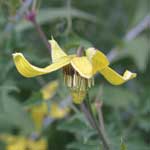Chinese Clematis
Clematis orientalis L.
Keys to Identification
- Chinese clematis is a perennial vine that is found along creeks, right-of-ways, and on rocky cliffs. It will climb fences, trees or similar structures but will form clumps if it does not have something to climb
- The distinctive single yellow flower has four petals and is 1 to 2 inches wide. We have a native clematis that is sometimes found in similar locations. The native has clusters of small white flowers
This information courtesy of the Colorado Natural Areas Program
Family
Ranunculaceae (Buttercup)
Other Names
Oriental Virginsbower, Orange Peel, Lemon Peel
USDA Code
CLOR
Legal Status
Colorado Noxious Weed List B
Identification
Lifecycle
Perennial
Growth form
Herbaceous to woody vine.
Flower
Flowers solitary, with 4 yellow sepals (petal-like structures), often nodding. June-Sept.
Seeds/Fruit
Each flower produces numerous feathery long-tailed achenes (single seeded fruits) which are conspicuous as the fruits mature.
Leaves
Opposite leaves, ternate (having 3 leaflets).
Stems
Vigorous climbing vines up to ten feet long.
Roots
No information available.
Seedling
No information available.
Other
Flowers are delicately scented.
Similar Species
Exotics
None known.
Natives
The native virgin’s bower (Clematis ligusticifolia), has white-sepaled flowers in clusters, and is much more common, especially at lower elevations.
Impacts
Agricultural
No information available.
Ecological
In the past 25 years Chinese clematis has spread especially rapidly, becoming weedy and constituting a threat to young trees and native shrubby and herbaceous species (Flora of North America Editorial Committee 1997).
Habitat and Distribution
General requirements
Most Clematis species prefer sunny, well drained soils, although they may be shade tolerant to some degree. In Utah, Chinese clematis is found in sagebrush, mountain brush, and ruderal habitats up to 7,500 ft (Welsh et al. 1987).
Distribution
Clematis orientalis has been naturalized in the Rocky Mountains since the late nineteenth century, and is now well established in Utah and Colorado, scattered in several other western states (Flora of North America Editorial Committee 1997). In Colorado, Chinese clematis is found in mountain areas, south and central.
Historical
Clematis species and hybrids are popular as ornamental garden plants.
Biology/Ecology
Life cycle
Perennial woody vine which flowers in summer to fall.
Mode of reproduction
Reproduces by seeds.
Seed production
No information available.
Dispersal
Wind, water, man.
References
Flora of North America Editorial Committee, eds. 1997. Flora of North America North of Mexico, Volume 3, Magnoliidae and Hamamelidae. Oxford University Press, New York.
Welsh, S.L., N.D. Atwood, L.C. Higgins, S. Goodrich. 1987. A Utah Flora. Great Basin Naturalist Memoir No. 9. Brigham Young University, Provo, Utah.


